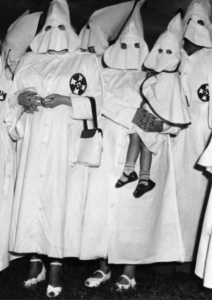David Harsanyi at The Federalist has an excellent commentary about journalism and how:
The State Of American ‘Fact-Checking’ Is Completely Useless
With a veneer of impartiality, fact-checkers engage in a uniquely dishonest style of partisanship.
– – – – – – – – – – – – – – – – – – – – – – – – – – – – – – – – – – – – – – – – – – – –
Democrat women claim suffrage movement – that’s rich
Many of the comments posted to the article are rich, even if a bit tangential, as was this one by realconservative referring to the silly girl-power-wear-white-look-at-us-stunt by Democrat women at Trump’s SOTU speech:
I havent seen that many democrats wear white since they marched with the KKK
Which is an appropriate dig which we are happy to illustrate.


We would add that any claim by Democrat women to championing women’s rights, currently does not apply to girl babies in utero, girl babies or any baby surviving abortion, nor Christian women, or conservative women who are often discriminated against and subject to their politically correct inquisitions.
The history of Republicans is far more supportive of all women. The Democrat women should have been wearing sackcloth and ashes (blackface??) in repentance for their party for a host of historic and current policy reasons that adversely affect women.
The Republican Party pioneered the right of women to vote and was consistent in its support throughout the long campaign for acceptance. It was the first major party to advocate equal rights for women and the principle of equal pay for equal work.
The Women’s Rights Convention held in Seneca Falls, N.Y., in 1848 marked the beginning of the women’s suffrage movement in the United States. Two years later there was a nationwide meeting in Worcester, Mass.
By 1870, the Massachusetts Republican State Convention had already seated two suffragettes, Lucy Stone and Mary A. Livermore, as delegates. In addition, the National Republican Convention of 1872 approved a resolution favoring the admission of women to “wider fields of usefulness” and added that “the honest demand of this class of citizens for additional rights … should be treated with respectful consideration.”
Wyoming, the state that pioneered women’s suffrage, sent two women, Therese A. Jenkins and Cora G. Carleton, to the 1892 Republican Convention in Minneapolis as alternate delegates. This was the first time women were seated at a Republican National Convention.
This convention was also the first to be addressed by a woman, J. Ellen Foster, chairman of the Women’s Republican Association of the United States. A strong believer in organization, Foster said her association had prepared work plans for women’s involvement in national politics. Copies were given to each delegate and alternate. “We are here to help you,” she declared, “and we are here to stay.”
At the request of Susan B. Anthony, Sen. A.A. Sargent, a Republican from California, introduced the 19th Amendment in 1878. Sargent’s amendment (also known as the Susan B. Anthony Amendment) was defeated four times by a Democrat-controlled Senate. When the Republican Party regained control of Congress in 1919, the Equal Suffrage Amendment finally passed the House in May of that year and in the Senate in June.
When the Amendment was submitted to the states, 26 of the 36 states that ratified it had Republican legislatures. Of the nine states that voted against ratification, eight were Democratic. Twelve states, all Republican, had given women full suffrage before the federal amendment was ratified.
On August 18, 1920, Tennessee became the 36th and final state needed to ratify the amendment. The U.S. Secretary of State certified the amendment on Aug. 26, 1920.
